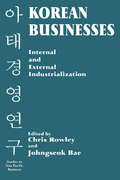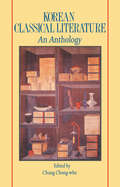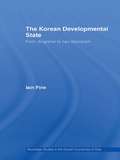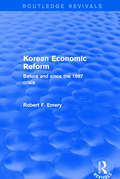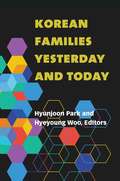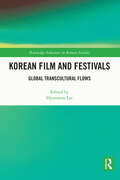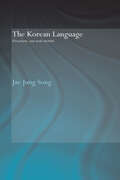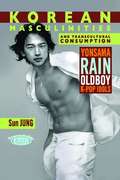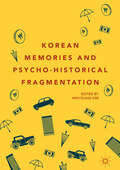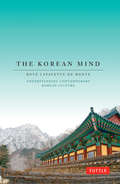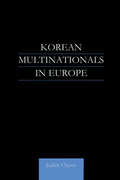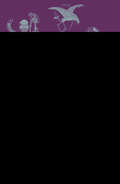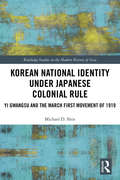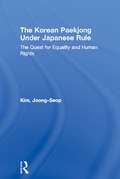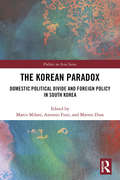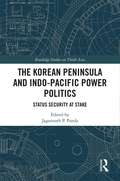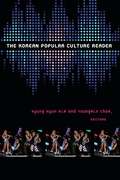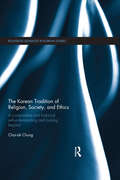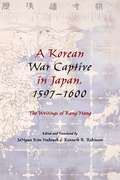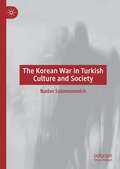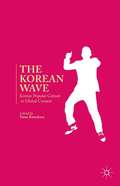- Table View
- List View
Korean Beauty Secrets: A Practical Guide to Cutting-Edge Skincare & Makeup
by Kerry Thompson Coco ParkBeauty tips and tricks from the salons of South Korea
Korean Businesses: Internal and External Industrialization (Studies In Asia Pacific Business)
by CHRIS ROWLEY; JOHNGSEOK BAEEssays in the book focus on the Korean model of industrialization and internal internationalization, organizational capabilities and management roles, and disadvantages inherent in the model. The subjects covered include corporate catch-up strategies, foreign investment, and future possibilities.
Korean Classical Literature
by Chung Chong-WhaFirst published in 1989. This is a collection of essays, excerpts of Korean classical literature including areas of romance, and selected work of Park Jiwon. Samsolgi is a collection of nine allegorical stories in three volumes, and works to stimulate the imagination.
The Korean Developmental State: From dirigisme to neo-liberalism (Routledge Studies in the Growth Economies of Asia #Vol. 73)
by Iain PirieThe Korean Developmental State is a comprehensive and up-to-date analysis of processes of state and economic restructuring in South Korea since the 1997 crisis. The book distinguishes itself from previous studies by consistently arguing that structural changes in the global political economy have played a crucial role in reshaping the Korean state’s own economic project. More precisely, Iain Pirie seeks to demonstrate how the Korean state increasingly adopted neo-liberal policies from the 1980s onwards as a rational response to the evolution of global economic structures; an evolution which has been driven by the continuous attempts of major global firms and leading capitalist states to overcome the chronic profitability problems that have dogged the core capitalist area since the late 1960s. The radical restructuring programme the Korean state initiated after the 1997 crisis must be understood as a logical conclusion to these earlier, more incremental, processes of reform it initiated almost two decades earlier. This book seeks to establish the neo-liberal character of the Korean state through a close analysis of key institutional and policy reforms, and serious engagement with more theoretical debates concerning the nature of the neo-liberal state itself. The Korean Developmental State offers a new perspective on the economic experience of Korea as a development model, one that emphasizes global trends and contradictions for Korea’s economic crisis and resulting transformation, and as such will be of significant interest to scholars of Korean studies and the Asian economy.
Korean Economic Reform: Before and Since the 1997 Crisis (Routledge Revivals Ser.)
by Robert F. EmeryThis title was first published in 2001. In 1997 the author was told, by an official at the Korean embassy in Washington DC, that the most serious economic problem facing Korea was the need for reform of the financial sector. This proved to be true, as a financial crisis hit Korea in November 1997. Though problems arising before November 1997 indicate that Korea's economic problems were not solely financial. This study covers earlier reform efforts, the 1997 crisis and the measures taken by Korea since then to deal with the country's economic problems. It attempts to analyze the problems and offer suggestions as to how problems might corrected or resolved.
Korean Families Yesterday and Today (Perspectives On Contemporary Korea)
by Hyunjoon Park Hyeyoung WooKorean families have changed significantly during the last few decades in their composition, structure, attitudes, and function. Delayed and forgone marriage, fertility decline, and rising divorce rates are just a few examples of changes that Korean families have experienced at a rapid pace, more dramatic than in many other contemporary societies. Moreover, the increase of marriages between Korean men and foreign women has further diversified Korean families. Yet traditional norms and attitudes toward gender and family continue to shape Korean men and women’s family behaviors. Korean Families Yesterday and Today portrays diverse aspects of the contemporary Korean families and, by explicitly or implicitly situating contemporary families within a comparative historical perspective, reveal how the past of Korean families evolved into their current shapes. While the study of families can be approached in many different angles, our lens focuses on families with children or young adults who are about to forge family through marriage and other means. This focus reflects that delayed marriage and declined fertility are two sweeping demographic trends in Korea, affecting family formation. Moreover, “intensive” parenting has characterized Korean young parents and therefore, examining change and persistence in parenting provides important clues for family change in Korea. This volume should be of interest not only to readers who are interested in Korea but also to those who want to understand broad family changes in East Asia in comparative perspective.
Korean Film and Festivals: Global Transcultural Flows (Routledge Advances in Korean Studies)
by Hyunseon LeeThis book examines the various film festivals where Korean cinema plays a significant role, both inside and outside of Korea, focusing on their history, structure and function, and analysis of successful festival films. Using Korean film festivals and Korean cinema at international film festivals as its primary lens, this interdisciplinary volume explores the shifting relationships between the multi-media genre of film and the fast-growing changing world of film festival cultures. It examines the changing aesthetics of Korean film in a transcultural context and historical (dis)continuity from a variety of angles from film and media studies, literary and cultural studies, Korean studies, Japanese studies, and also from film festival practice. Moreover, through comprehensive examinations of both domestic and international film festivals from the perspectives of production, distribution and marketing it highlights the reception of Korean cinema outside of Korea in an increasingly globalised industry. Featuring the contributions of expert scholars of international film and Korean cinema, in addition to interview material with a practicing film professional, this book will be of huge interest to students and scholars of Korean and Asian film and media studies, as well as those interested in the impact of film festivals more generally.
Korean Immigrants in Canada
by Samuel Noh Marianne Noh Ann KimKoreans are one of the fastest-growing visible minority groups in Canada today. However, very few studies of their experiences in Canada or their paths of integration are available to public and academic communities. Korean Immigrants in Canada provides the first scholarly collection of papers on Korean immigrants and their offspring from interdisciplinary, social scientific perspectives.The contributors explore the historical, psychological, social, and economic dimensions of Korean migration, settlement, and integration across the country. A variety of important topics are covered, including the demographic profile of Korean-Canadians, immigrant entrepreneurship, mental health and stress, elder care, language maintenance, and the experiences of students and the second generation. Readers will find interconnecting themes and synthesized findings throughout the chapters. Most importantly, this collection serves as a platform for future research on Koreans in Canada.
The Korean Language: Structure, Use and Context
by Jae Jung SongSuitable for students of all levels, this book provides a general description of the Korean language by highlighting important structural aspects whilst keeping technical details to a minimum. By examining the Korean language in its geographical, historical, social and cultural context the reader is able to gain a good understanding of its speakers and the environment in which it is used. The book covers a range of topics on Korean including its genetic affiliation, historical development, sound patterns, writing systems, vocabulary, grammar and discourse. The text is designed to be accessible, primarily to English-speaking learners of Korean and scholars working in disciplines other than linguistics, as well as serving as a useful introduction for general linguists. The book complements Korean language textbooks used in the classroom and will be welcomed not only by readers with a wider interest in Korean studies, but also by Asian specialists in general.
Korean Masculinities and Transcultural Consumption
by Sun JungSouth Korean masculinities have enjoyed dramatically greater influence in recent years in many realms of pan-Asian popular culture, which travels freely in part because of its hybrid trans-nationalistic appeal. This book investigates transcultural consumption of three iconic figures - the middle-aged Japanese female fandom of actor Bae Yong-Joon, the Western online cult fandom of the thriller film 'Oldboy,' and the Singaporean fandom of the pop-star Rain. Through these three specific but hybrid contexts, the author develops the concepts of soft masculinity, as well as global and postmodern variants of masculine cultural impacts. In the concluding chapter, the author also discusses recently emerging versatile masculinity within the transcultural pop production paradigm represented by K-pop idol boy bands.
Korean Memories and Psycho-Historical Fragmentation
by Mikyoung KimThis pioneering book is the first English volume on Korean memories. In it, Mikyoung Kim introduces ‘psycho-historical fragmentation’, a concept that explains South Korea’s mnemonic rupture as a result of living under intense temporal, psychological and physical pressure. As Korean society has undergone transformation at unusual speed and intensity, so has its historical memory. Divided into three sections, on lingering colonial legacies, the residuals of the Cold War and Korean War, and Korea’s democracy movement in the 1980s, Korean Memories and Psycho-Historical Fragmentation aims to tell multi-layered, subtle and lesser-known stories of Korea’s historical past. With contributions from interdisciplinary perspectives, it reveals the fragmentation of Korean memory and the impact of silencing.
The Korean Mind: Understanding Contemporary Korean Culture
by Boye Lafayette De MenteThe Koreans: understanding a people and their culture through key words and language.Koreans have a unique character and personality that sets them apart from all other Asians. <P><P>And although Korean attitudes and behavior may be influenced by the modern world, the Korean mindset is still very much shaped by ancient culture and traditions. As is the case with all ancient cultures created within highly refined and meticulously structured social systems over thousands of years, one of the keys to understanding traditional Korean attitudes and behavior is the language of the people-or more precisely, key words in the language. These key words provide access to the Korean mind-to core concepts and emotions, the attitudes and feelings that make up the Korean psyche. These key terms reveal both the heart and soul of Koreans and provide bridges for communicating and interacting with Koreans on the most fundamental level.In The Korean Mind, Boye Lafayette De Mente explores the meanings and cultural context of the most important "code words" of the Korean language, terms whose significance goes well beyond their literal definitions, providing an insight into Korean culture and the personality of the Korean people.
Korean Multinationals in Europe (Routledge Advances in Korean Studies)
by Judith CherryExplores Korean foreign direct investment, putting forward a theoretical framework to explain why the Korean conglomerates felt compelled to invest in western, central and eastern Europe.
The Korean Myths: A Guide To The Gods, Heroes And Legends (Myths #0)
by Heinz Insu Fenkl Bella Myong-wol Dalton-FenklA fascinating introduction to the world of Korean myth and legend. The myths of Korea may seem a complex and intriguing mix of ghosts, spirits, and superstition, but they form the bedrock of one of the most vibrant global cultures today. In the past few decades, South Korea has experienced a rapid rise to prominence on the world stage as the Hallyu, the "Korean wave" of popular culture, drives newfound interest in the country. This swift transformation has also generated paradoxes within contemporary South Korea, where cutting-edge technology now coexists with centuries-old shamanistic legends and Buddhist rituals. Korean myths are a living and evolving part of society, in both the North and South. With the export of Korean film across the globe, K-pop, fashion, K-dramas, literature, and comics there is a growing desire to understand the folklore and mythical underpinnings of contemporary Korean culture. Authors Heinz Insu Fenkl and Bella Dalton-Fenkl bring together a wealth of knowledge of both the new and the old, the traditional and the modern, to guide readers through this fascinating history and help them understand the culture and traditions of the Korean people. From the Changsega ("Song of Creation") sung by shamans to the gods, goddesses, and monsters who inhabit the cosmos—including the god Mireuk, creator of the world, and the giant Grandma Mago, who was able to create mountains from the mud on her skirt—these myths have been disseminated for centuries and continue to resonate in popular culture today.
Korean National Identity under Japanese Colonial Rule: Yi Gwangsu and the March First Movement of 1919 (Routledge Studies in the Modern History of Asia)
by Michael ShinModern Korean nationalism has been shaped by the turbulent historical forces that shook and transformed the peninsula during the twentieth century, including foreign occupation, civil war, and division. This book examines the emergence of the nation as the hegemonic form of collective identity after the March First Movement of 1919, widely seen as one of the major turning points of modern Korean history. The analysis focuses on Yi Gwangsu (1892–1950), a pioneering novelist, newspaper editor, and leader of the nationalist movement, who was directly involved in many aspects of its emergence during the Japanese occupation period. Yi Gwangsu was one of the few intellectuals who not only wrote for almost the entirety of the colonial period but who also was centrally involved in many institutions related to the production of identity. By focusing on Yi Gwangsu the book provides a different kind of historical narrative linking the various fragments of the nation, puts forward a new understanding of the March First Movement and its role in the emergence of the nation, and demonstrates how central to the emergence of the nation were the development of the print industry, the rise of a modern readership, and the emergence of a capitalist market for print. This book shows how the March First Movement catalyzed the confluence of these factors, enabling the nation to emerge as the dominant form of collective identity.
The Korean Paekjong Under Japanese Rule: The Quest for Equality and Human Rights
by Joong-Seop KimTraditional Korean society was characterized by a rigid hierarchy. The minority Paekjong were the lowest group of the lowest rank of the shinbun class system, and were treated as outcasts throughout the Choson period (1392-1910). This book deals with their historical and social background, and their struggle for human rights and equality in colonial Korea through the activities of the Hyongpyongsa (Association for an Equitable Society), active from c.1923 to 1935. The Hyongpyongsa was the longest-lasting social movement during the colonial period, and its activities provoked confrontations with fellow Koreans as well as with the Japanese colonial powers. Through analysis of the social environment as well as their actions, this study reveals the complexity of early twentieth century Korea's drive towards modernization.
The Korean Paradox: Domestic Political Divide and Foreign Policy in South Korea (Politics in Asia)
by Marco Milani Antonio Fiori Matteo DianBringing together an international line up of contributors, this book examines South Korea’s foreign policy strategies designed to cope with the challenges of the post-Cold War regional order and the emergence of a "Korean paradox". Focusing on non-material factors in shaping the decision-making processes of primary actors, such as traditions, beliefs, and identities, this book begins by analysing the emergence of the "Asian Paradox" and explores how different political traditions have influenced South Korea’s foreign and security policies. In the second part (from Chapter 4), this book goes on to deal directly with the key issues in South Korea’s foreign policy today, with an emphasis on the progressive and conservative approaches to the challenges the country faces. This includes the North Korean threat, the alliance with the U.S., relations with China and Russia, the complicated relationship with Japan, and the emerging role of South Korea outside of Northeast Asia. An innovative study of the domestic sources of South Korean foreign policy, The Korean Paradox investigates South Korea’s growing role at both regional and global levels. As such, it will be useful to students and scholars of Korean Studies, International Relations and East Asian Studies more generally.
The Korean Peninsula and Indo-Pacific Power Politics: Status Security at Stake (Routledge Studies on Think Asia)
by Jagannath P. PandaThis book assesses the strategic linkages that the Korean Peninsula shares with the Indo-Pacific and provides a succinct picture of issues which will shape the trajectory of the Korean Peninsula in the future.This book analyses how critical actors such as the United States, China, Russia and Japan are caught in a tightly balanced power struggle affecting the Korean Peninsula. It shows how these countries are exerting control over the Korean Peninsula while also holding on to their status as critical actors in the broader Indo-Pacific. The prospects of peace, stability and unity in the Korean Peninsula and the impact of this on Indo-Pacific power politics are explored as well as the contending and competing interests in the region. Chapters present country-specific positions and approaches as case studies and review the impact of power politics on stakeholders’ relationships in the Indo-Pacific. The book also argues that the Korean Peninsula and the issue of denuclearization is of primary importance to any direction an Indo-Pacific Partnership may take.Bringing together scholars, journalists and ex-diplomats, this book will be of interest to academics working in the field of international relations, foreign policy, security studies and Asian studies as well as audiences interested
The Korean Popular Culture Reader
by Youngmin Choe Kyung Hyun KimOver the past decade, Korean popular culture has become a global phenomenon. The "Korean Wave" of music, film, television, sports, and cuisine generates significant revenues and cultural pride in South Korea. The Korean Popular Culture Reader provides a timely and essential foundation for the study of "K-pop," relating the contemporary cultural landscape to its historical roots. The essays in this collection reveal the intimate connections of Korean popular culture, or hallyu, to the peninsula's colonial and postcolonial histories, to the nationalist projects of the military dictatorship, and to the neoliberalism of twenty-first-century South Korea. Combining translations of seminal essays by Korean scholars on topics ranging from sports to colonial-era serial fiction with new work by scholars based in fields including literary studies, film and media studies, ethnomusicology, and art history, this collection expertly navigates the social and political dynamics that have shaped Korean cultural production over the past century.Contributors. Jung-hwan Cheon, Michelle Cho, Youngmin Choe, Steven Chung, Katarzyna J. Cwiertka, Stephen Epstein, Olga Fedorenko, Kelly Y. Jeong, Rachael Miyung Joo, Inkyu Kang, Kyu Hyun Kim, Kyung Hyun Kim, Pil Ho Kim, Boduerae Kwon, Regina Yung Lee, Sohl Lee, Jessica Likens, Roald Maliangkay, Youngju Ryu, Hyunjoon Shin, Min-Jung Son, James Turnbull, Travis Workman
The Korean Tradition of Religion, Society, and Ethics: A Comparative and Historical Self-understanding and Looking Beyond (Routledge Advances in Korean Studies)
by Chai-sik ChungBy making Korea a central part of comparative history of East Asian religion and society, this book traces the evolution of Korean religion from the oldest representation to that of the current day by utilizing wide-ranging interdisciplinary and comparative resources. This book presents a holistic view of the enduring religious tradition of Korea and its cultural and social significance within the wider horizons of modern and globalizing changes. Reflecting nearly five decades of the author’s work on the subject, it presents an understanding of the main current in Korean religion and social thought throughout history. It then goes on to examine discourses on values and morality involving the relationship between religion and society, in particular the human meaning of economy and society, which is one of the most central and practical problems in the contemporary world with global relevance beyond Korea and Asia. Addressing the overview of the Korean religious tradition in the context of its impact on the making of modern society and economy, this book will appeal to students and scholars of Religious Studies, Korean Studies and Asian Studies.
A Korean War Captive in Japan, 1597–1600: The Writings of Kang Hang
by Kenneth Robinson JaHyun Kim HaboushKang Hang was a Korean scholar-official taken prisoner in 1597 by an invading Japanese army during the Imjin War of 1592–1598. While in captivity in Japan, Kang recorded his thoughts on human civilization, war, and the enemy's culture and society, acting in effect as a spy for his king. Arranged and printed in the seventeenth century as Kanyangnok, or The Record of a Shepherd, Kang's writings were extremely valuable to his government, offering new perspective on a society few Koreans had encountered in 150 years and new information on Japanese politics, culture, and military organization.In this complete, annotated translation of Kanyangnok, Kang ruminates on human behavior and the nature of loyalty during a time of war. A neo-Confucianist with a deep knowledge of Chinese philosophy and history, Kang drew a distinct line between the Confucian values of his world, which distinguished self, family, king, and country, and a foreign culture that practiced invasion and capture, and, in his view, was largely incapable of civilization. Relating the experiences of a former official who played an exceptional role in wartime and the rare voice of a Korean speaking plainly and insightfully on war and captivity, this volume enables a deeper appreciation of the phenomenon of war at home and abroad.
The Korean War in Turkish Culture and Society
by Nadav SolomonovichThis book explores the important role that the Korean War played in Turkish culture and society in the 1950s. Despite the fact that fewer than 15,000 Turkish soldiers served in Korea, this study shows that the Turkish public was exposed to the war in an unprecedented manner, considering the relatively small size of the country’s military contribution. It examines how the Turkish people understood the war and its causes, how propaganda was used to ‘sell’ the war to the public, and the impact of these messages on the Turkish public. Drawing on literary and visual sources, including archival documents, newspapers, protocols of parliamentary sessions, books, poems, plays, memoirs, cartoons and films, the book shows how the propaganda employed by the state and other influential civic groups in Turkey aimed to shape public opinion regarding the Korean War. It explores why this mattered to Turkish politicians, viewing this as instrumental in achieving the country’s admission to NATO, and why it mattered to Turkish people more widely, seeing instead a war in the name of universal ideas of freedom, humanity and justice, and comparing the Turkish case to other states that participated in the war.
The Korean Wave: Korean Media Go Global (Internationalizing Media Studies)
by Youna KimSince the late 1990s South Korea has emerged as a new center for the production of transnational popular culture - the first instance of a major global circulation of Korean popular culture in history. Why popular (or not)? Why now? What does it mean socially, culturally and politically in a global context? This edited collection considers the Korean Wave in a global digital age and addresses the social, cultural and political implications in their complexity and paradox within the contexts of global inequalities and uneven power structures. The emerging consequences at multiple levels - both macro structures and micro processes that influence media production, distribution, representation and consumption - deserve to be analyzed and explored fully in an increasingly global media environment. This book argues for the Korean Wave's double capacity in the creation of new and complex spaces of identity that are both enabling and disabling cultural diversity in a digital cosmopolitan world. The Korean Wave combines theoretical perspectives with grounded case studies in an up-to-date and accessible volume ideal for both undergraduate and postgraduate students of Media and Communications, Cultural Studies, Korean Studies and Asian Studies.
The Korean Wave
by Yasue KuwaharaThe rise in popularity of South Korean entertainment and culture began and is promoted as an official policy of the Korean government to revive the country's economy. This study examines cultural production and consumption, glocalization, the West versus. Asia, global race consciousness, and changing views of masculinity and femininity.
Korean Wave in South Asia: Transcultural Flow, Fandom and Identity
by Ratan Kumar Roy Biswajit DasThis book is a systematic investigation of Korean cultural wave in South Asia, discovering and analysing the dynamics of fandom, mechanism of media industry and growing phenomena of Korean culture in this part of the world. This is one of the very first academic volumes in South Asia that examines cultural politics, language and literatures of Korea in a regional location when there might be some on examining the political and diplomatic relations divorced from socio-cultural interactions. It focuses on three major aspects: identity formation in the age of digital culture, fandom and aspiration in the wake of subculture, and transcultural flow in South Asia. Through these thematic indicators and empirical instances the volume explores the modes of transcultural flow vis a via the global cultural flow. The patterns and processes of identity construction transformed among the teenagers and youths in the realm of digital media and embodying the Korean cultural elements. The book will contribute in the area of media and cultural studies, global culture and politics, arts and humanities, social sciences and area studies.Chapter 1 is available open access under a Creative Commons Attribution 4.0 International License via link.springer.com.

